Lower Impact Eating – How to Get Started
If you want to make a positive change in your life, why not start with your diet? Eating the right foods that give you energy and help your body fight illness, recover from injury, and maintain a good weight can have a huge impact on your day-to-day life. But, how can you know which foods are the right ones to eat?
When Diet Meets Meat
As a society, we are all trying to eat healthier. With the increase in knowledge of the plight of the planet and the health risks associated with eating meat, it is easier than ever to practice a more plant-based diet. Vegans and vegetarians have been preaching the benefits of a lower impact eating lifestyle for years, but most people can’t let go of their meat-based diets overnight.
An important aspect of eating less meat is the fact that many of us don’t have the same access to a wide variety of vegan (and vegetarian) foods that those in, say, New York or Los Angeles do. For those of us who live in smaller towns, finding vegan and vegetarian alternatives to the foods we grew up with (think pizza or tacos) and the chance to try new foods (such as seitan or tempeh) can be a challenge. But it doesn’t have to be! You can do plenty of things to make your diet more sustainable, and you don’t have to spend a fortune. You might want to start slowly with low-impact eating.
What is Lower Impact Eating?
To eat less and lose more weight requires more than just good intentions. It also involves a good plan and plenty of preparation. There are two basic ways to eat less. The first is to eat less food, and the second is to eat low-impact food. If you are going to focus on one, it should probably be the second because you can eat the first one for a few days, but you can’t eat the second for a few days and expect to stay healthy. By low-impact food, we mean to eat food that is healthier for you and that has a smaller impact on the environment.
The phrase “lower impact eating” (or “less impact eating”) might sound like a contradiction in terms, but there are ways to eat that have a smaller negative impact on both your health and the environment. Here are steps on how to get you started:
- Figure out why you want to lower your impact on the environment. People with this goal might want to reduce food waste, eliminate non-recyclable items, or just live more sustainably. But how can you make a positive change for the environment? It can be hard to figure out what to do first or to make it part of your everyday life. The truth is, there is no one right way to lower your impact.
- You need to figure out what you want to eat and how much you’re willing to spend on it. Finding a diet that works for you will also take some experimentation. You need to figure out what you want to eat and how much you’re willing to spend on it. It’s better to pick a diet you can stick to rather than one you might give up on after a few short weeks. You may also want to try a few different diets before you find the one that is right for you.
- You need to make a list of all the things you can do to lower your impact and pick the ones you want to do. There are many ways you can reduce your environmental impact. You can buy local food, shop at thrift stores, and reuse items like plastic containers. You can drive less, turn down the heat, and use public transportation, among other things.
Eating food that is lower in impact is straightforward. If you want to eat more greens, load up on greens. If you want to eat less meat, eat less meat. You can also cut back on dairy products, grains, and processed foods. A lot of it comes down to what tastes good to you. While some people can’t live without their meat, others are vegetarian or vegan and wouldn’t want to eat meat if they tried. No matter what you eat, be sure to eat only as much as you need, and eat one or two small meals a day rather than three or more.


